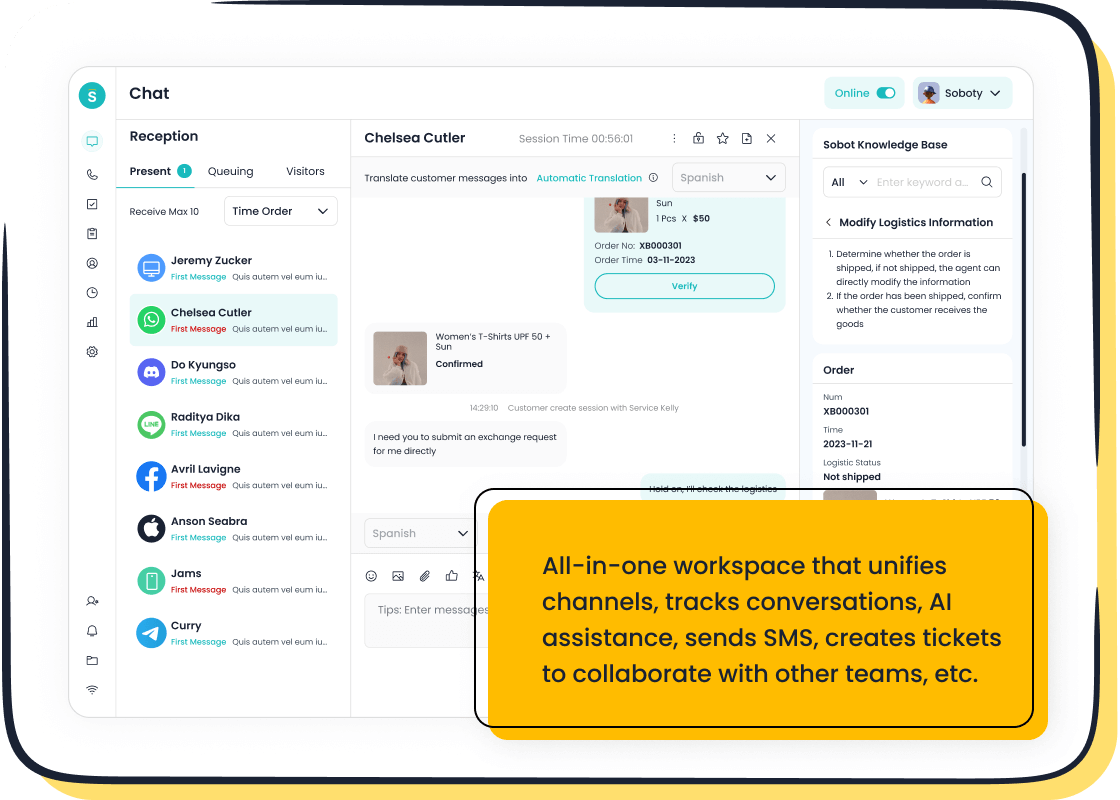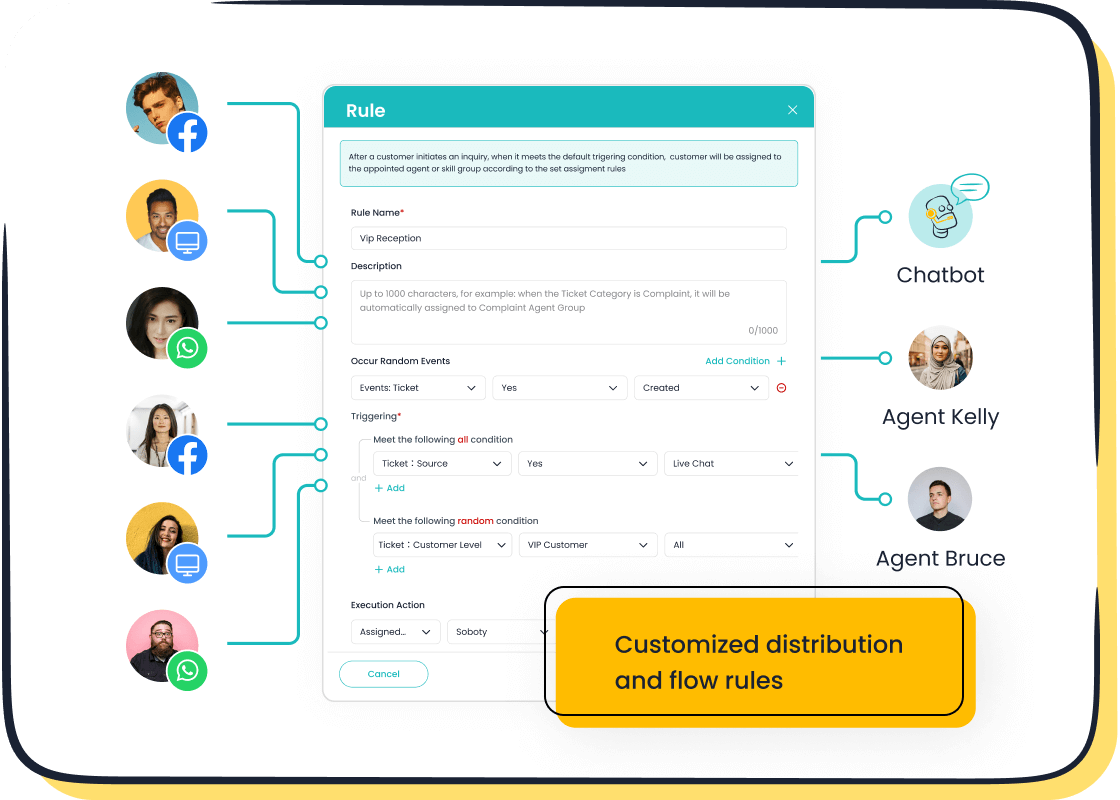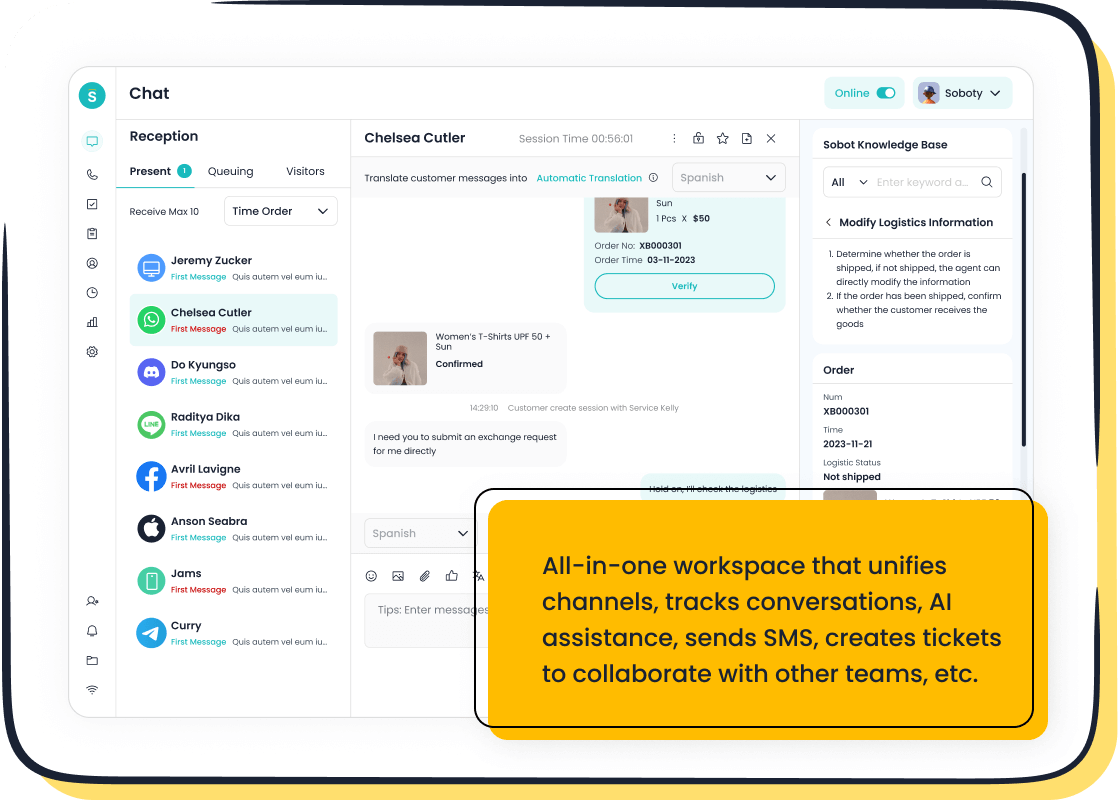Why Customer Support Systems Are Crucial in 2025

In 2025, customer support systems play a vital role in shaping business success. You face a world where 90% of customers expect their questions answered in under 10 minutes. Personalized assistance has become a standard, with 71% of consumers demanding service tailored to their past interactions. These systems not only meet these expectations but also drive growth. For instance, 80% of customers value their experience with a company as much as its products. Tools like Sobot empower businesses to deliver seamless support, ensuring satisfaction and loyalty in a competitive market.
Understanding Customer Support Systems
What Are Customer Support Systems?
Customer support systems are tools or platforms designed to help businesses manage and improve their interactions with customers. These systems streamline communication, ensuring that customers receive timely and effective assistance. Whether through live chat, email, or social media, a customer support system acts as a bridge between businesses and their customers, enhancing the overall customer experience.
Modern customer support systems often integrate advanced technologies like AI and automation. For example, AI-powered chatbots provide 24/7 availability, ensuring customers can get help anytime. These systems also scale effortlessly, handling high volumes of inquiries during peak times. Personalization is another key feature, as these platforms use customer data to tailor responses, fostering loyalty and satisfaction.
| Benefit | Description |
|---|---|
| 24/7 Availability | AI chatbots provide constant support, meeting customer expectations for help at any time. |
| Scalability | AI can handle a large volume of inquiries, allowing businesses to manage peak times efficiently. |
| Personalization | AI can tailor responses based on customer data, enhancing the support experience and customer loyalty. |
Core Functions of a Customer Support System
A customer support system serves multiple purposes, all aimed at improving customer satisfaction and operational efficiency. These systems utilize various support channels, including phone, email, live chat, and social media, to ensure seamless communication. They also distinguish between customer service, which focuses on long-term relationships, and customer support, which addresses immediate issues.
Key functions include:
- Proactive engagement to anticipate customer needs.
- Data analytics to monitor performance and identify trends.
- Customer feedback loops to gather insights for improvement.
- Cross-functional collaboration to resolve issues efficiently.
For instance, a Canadian telecommunications company implemented a cloud-based customer support platform. This system integrated post-call surveys, real-time reporting, and IVR self-service, leading to significant improvements in customer satisfaction.
Examples of Effective Customer Support Tools
Effective customer support tools are essential for delivering exceptional service. These tools enhance response times, resolution rates, and overall customer satisfaction. Metrics like AI integration and omnichannel support highlight their impact.
| Metric | Description |
|---|---|
| Response Times | Measures how quickly customer support responds to inquiries. |
| Resolution Rates | Indicates the percentage of issues resolved on the first contact. |
| Customer Satisfaction Scores | Reflects how satisfied customers are with the support they received. |
| AI Integration | Utilizes AI and machine learning to enhance response quality and speed. |
| Omnichannel Support | Allows customers to interact through various channels seamlessly. |
| Self-Service Options | Provides customers with tools to resolve issues independently, reducing support team workload. |

Sobot’s Live Chat exemplifies an effective customer support tool. It offers omnichannel support, AI-assisted tools, and built-in analytics, enabling businesses to deliver personalized and efficient service. With features like auto-translation and customizable widgets, Sobot Live Chat ensures no customer interaction is missed, boosting satisfaction and loyalty.
The Importance of Customer Support Systems in 2025
Meeting Evolving Customer Expectations
In 2025, customers expect fast, personalized, and seamless interactions. Businesses must adapt to these evolving needs to remain competitive. Customer support systems play a pivotal role in meeting these expectations. For example, 80% of customers believe that their experience with a company is as important as the product or service itself. This highlights the growing importance of delivering outstanding customer support.
Modern customer support systems enable businesses to provide proactive engagement. They anticipate customer needs and offer solutions before issues arise. Features like omnichannel support ensure customers can connect through their preferred platforms, whether it’s live chat, email, or social media. Additionally, self-service options empower customers to resolve simple issues independently, reducing the volume of incoming requests. These capabilities not only enhance the customer experience but also build trust and satisfaction.
Enhancing Customer Retention and Loyalty
Customer retention is critical for long-term success. Studies show that 77% of business leaders recognize personalized service as a key driver of retention. Effective customer support systems help businesses achieve this by fostering customer loyalty through tailored interactions. By using customer data, these systems create personalized experiences that make customers feel valued.
Outstanding customer support also reduces churn. Proactive engagement and quick resolutions ensure customers remain satisfied. For instance, resolving issues during the first interaction can prevent 67% of customer churn. This not only saves acquisition costs but also strengthens customer relationships. Businesses that prioritize customer-centric approaches see higher retention rates and increased lifetime value.
Driving Operational Efficiency and Business Growth
Customer support systems contribute significantly to operational efficiency. They streamline workflows, automate repetitive tasks, and enable agents to focus on complex issues. This improves response times and reduces customer frustration. For example, integrating AI-driven tools allows businesses to handle high volumes of inquiries without compromising quality.
Efficient customer support directly impacts business growth. Retaining customers through optimal support interactions ensures steady revenue streams. Additionally, data analytics from these systems provide actionable insights, helping businesses refine their strategies. By addressing customer feedback and improving processes, companies can achieve sustainable growth while maintaining high levels of customer satisfaction.
Key Benefits of Implementing Customer Support Systems

Faster Response Times and Seamless Resolutions
Customer support systems improve response times and ensure seamless resolutions. Advanced tools like AI-powered chatbots handle incoming requests instantly, reducing wait times for customers. For example, top-performing systems achieve an average first response time of just 0.54 hours, ensuring customers receive timely assistance. This speed enhances customer satisfaction and builds trust.
Efficient workflows also contribute to faster resolutions. By automating repetitive tasks, these systems allow agents to focus on complex issues. Features like intelligent assignment and unified workspaces streamline operations, ensuring no customer query goes unresolved. Businesses that prioritize outstanding customer support see improved retention rates and higher customer loyalty.
| Metric | Description | Average Time (Top Performers) |
|---|---|---|
| First Response Time (FRT) | Time taken to reply to the first customer message. | 0.54 hours |
| Average Reply Time | Time taken to respond to any customer support message. | Similar to FRT |
| Average Resolution Time | Time taken to resolve customer queries. | Varies based on methods used |

Personalized Customer Experiences with Tools Like Sobot Live Chat
Personalization is key to delivering world-class customer service. Tools like Sobot Live Chat enable businesses to create tailored experiences by leveraging customer data. With features like customer segmentation and AI-assisted tools, Sobot helps you meet customer needs effectively. For instance, businesses using Sobot Live Chat report a 97% improvement in customer satisfaction and a 35% increase in sign-off rates.
Omnichannel support ensures customers can interact through their preferred platforms, whether it’s WhatsApp, Facebook, or Instagram. This flexibility fosters customer-centric interactions and boosts retention. Additionally, self-service options empower customers to resolve simple issues independently, reducing the workload on support teams. These capabilities make Sobot Live Chat an effective customer support tool for enhancing customer experiences.

Data-Driven Insights for Strategic Decision-Making
Customer support systems provide valuable data-driven insights that inform strategic decisions. By analyzing customer feedback and interaction data, businesses can identify trends and optimize their operations. For example, Uber uses big data to forecast demand and allocate drivers efficiently, improving customer satisfaction and operational efficiency.
Sobot’s built-in analytics evaluate over 150 indicators, offering actionable insights for continuous improvement. These insights help you refine your strategies, address customer needs proactively, and enhance customer retention. Companies like Best Buy and Wipro have successfully leveraged data analytics to personalize marketing efforts and improve service quality. With tools like Sobot Live Chat, you can turn data into a competitive advantage.
| Company | Insight/Strategy | Impact on Business |
|---|---|---|
| Uber | Utilizes big data for real-time analysis of driver behavior and demand forecasting | Enhances customer satisfaction and operational efficiency through optimized driver allocation and surge pricing. |
| Wipro | Advanced data analysis for tech support and predictive maintenance | Reduces downtime and improves client satisfaction by anticipating system issues. |
| Best Buy | Analyzes customer purchase data for personalized marketing and inventory management | Improves customer experience and aligns product offerings with market trends. |
Trends Shaping Customer Support Systems in 2025

The Role of AI and Automation in Customer Support
AI and automation are transforming customer support by enhancing efficiency and improving customer engagement. In 2025, 42% of contact centers plan to adopt AI, while 80% of companies aim to use AI-powered chatbots. These tools handle repetitive tasks, allowing agents to focus on complex issues. For example, AI-driven chatbots provide instant responses, ensuring customers receive timely assistance. This reduces wait times and boosts satisfaction.
Generative AI is another game-changer. It enables personalized interactions by analyzing customer data and tailoring responses. Tools like Sobot Live Chat leverage AI to offer features such as intelligent assignment and auto-translation, ensuring seamless communication across channels. By adopting AI, you can meet customer needs more effectively and enhance customer retention.

Omnichannel Solutions for Unified Customer Experiences
Omnichannel solutions are essential for delivering a unified customer experience. These systems allow customers to interact with your business through their preferred channels, whether it’s social media, email, or live chat. This flexibility fosters customer-centric engagement and improves retention. Metrics like Customer Lifetime Value (CLV) and Net Promoter Score (NPS) highlight the effectiveness of omnichannel support.

Sobot’s Omnichannel Solution exemplifies this trend. It integrates multiple communication channels into a unified workspace, enabling agents to provide consistent service. Features like AI-driven chatbots and built-in analytics enhance efficiency, while self-service options empower customers to resolve simple issues independently. By adopting omnichannel solutions, you can improve customer satisfaction and streamline operations.
| Metric | Description |
|---|---|
| Customer Lifetime Value (CLV) | Measures the total revenue a business can expect from a customer over the entire relationship. |
| Customer Satisfaction Score (CSAT) | Gauges customer satisfaction with interactions, highlighting areas for improvement. |
| Net Promoter Score (NPS) | Measures customer loyalty and likelihood to recommend the brand, reflecting overall customer sentiment. |
Integration with CRM and Other Business Systems
Integrating customer support systems with CRM and other business tools enhances operational efficiency. This integration automates repetitive tasks, reduces manual data entry, and ensures accurate, real-time information. For example, centralized data allows agents to access customer histories, enabling personalized interactions.
Sobot’s Live Chat integrates seamlessly with CRM platforms, providing a unified view of customer interactions. This improves collaboration between departments and enhances decision-making. By measuring KPIs like customer satisfaction scores and sales conversion rates, you can assess the impact of these integrations. Adopting such systems ensures your business remains competitive in a customer-centric market.
| Aspect | Description |
|---|---|
| Operational Efficiency | Automates repetitive tasks, reduces manual data entry, and improves collaboration between departments. |
| Improved Data Accuracy | Centralizes data, minimizes errors, and ensures decisions are based on reliable, real-time information. |
| Measuring Impact | Establishes KPIs like customer satisfaction scores and sales conversion rates to assess CRM effectiveness. |
Optimizing Your Customer Support System for Success
Assessing and Upgrading Your Current Infrastructure
To implement an efficient customer support system, you must first evaluate your current infrastructure. Start by analyzing key metrics like response times, resolution rates, and customer satisfaction scores. These insights help identify gaps and areas for improvement. For example, 80% of companies using AI reported enhanced customer experiences by 2023. This highlights the importance of integrating advanced technologies into your system.
Upgrading your infrastructure involves adopting tools that streamline operations and improve efficiency. AI-powered chatbots, like those offered by Sobot, handle repetitive support queries, freeing agents to focus on complex issues. Additionally, omnichannel solutions ensure seamless communication across platforms, enhancing the customer experience. Training your team on these upgrades ensures smooth adoption and consistent service delivery.
| Statistic | Description |
|---|---|
| 80% of companies | Using AI to improve customer experience by 2023. |
| 35% of organizations | Using AI to enhance agent efficiency in 2024. |
| AI customer service sector | Expected to reach $4.1 billion by 2027. |

Leveraging Sobot’s Live Chat for Omnichannel Support
Sobot’s Live Chat is a powerful tool for optimizing customer support. It offers omnichannel support, allowing customers to connect through their preferred platforms, such as WhatsApp, Facebook, or Instagram. This flexibility ensures no interaction is missed, improving customer satisfaction and loyalty.

The platform’s AI-assisted tools enhance efficiency by automating repetitive tasks and providing intelligent assignment features. Built-in analytics evaluate over 150 indicators, offering actionable insights to refine your strategies. For example, businesses using Sobot Live Chat report a 38% increase in conversion rates and a 97% improvement in customer satisfaction. These capabilities make it an essential component of any modern customer support system.
Training Teams and Monitoring Performance Metrics
Effective training is crucial for empowering customer support teams. Comprehensive training ensures agents understand the tools and processes, enabling them to deliver consistent service. Use engaging methods like gamification to improve skill retention. Real-time practice and feedback mechanisms further enhance learning outcomes.
Monitoring performance metrics helps you track progress and identify areas for improvement. Key performance indicators (KPIs) like average handling time, customer service ratings, and ticket volume provide valuable insights. For instance, tracking average resolution time helps you measure how quickly issues are resolved, ensuring customers receive timely assistance.
| KPI | Description |
|---|---|
| Average Handling Time | Measures the time taken to handle customer interactions. |
| Customer Service Ratings | Reflects customer satisfaction with service. |
| Average Resolution Time | Indicates how quickly issues are resolved. |
By combining effective training with performance monitoring, you can build a high-performing team capable of delivering exceptional customer service.
Continuous Improvement Through Analytics and Feedback
Continuous improvement is essential for maintaining an effective customer support strategy. By leveraging analytics and feedback, you can identify areas for growth and refine your approach to meet customer expectations. This process ensures your customer support evolves alongside changing demands.
One way to achieve continuous improvement is by collecting feedback through multiple channels. Surveys, social media, and direct calls provide diverse insights into customer experiences. Tailoring feedback requests to specific interactions ensures the data you gather is relevant and actionable. For example, asking for feedback immediately after resolving an issue can highlight areas where your team excels or needs improvement.
Analytics also play a crucial role in refining your customer support strategy. Advanced tools like speech analytics help identify recurring themes and sentiments in customer conversations. These insights allow you to address common pain points and enhance service delivery. Establishing performance baselines and setting iterative goals ensures your team stays focused on measurable improvements.
The table below outlines methods you can use to drive continuous improvement:
| Method | Description |
|---|---|
| Multichannel communication | Utilize various feedback channels like surveys, calls, and social media to gather diverse insights. |
| Context-sensitive collection | Tailor feedback requests to specific customer interactions for relevant data. |
| Customer success management | Train managers to gather insights through ongoing customer interactions. |
| Leveraging technology | Use advanced tools like speech analytics to identify themes and sentiments in customer conversations. |
| Establishing baselines | Conduct assessments to evaluate current performance metrics and set improvement timelines. |
| Setting iterative goals | Regularly analyze feedback to adjust goals for continuous improvement. |
| Strategic implementation | Use feedback to refine customer experience strategies and address operational inefficiencies. |
| Performance measurement | Adjust KPIs based on customer feedback to prioritize important metrics. |
| Technology integration | Implement AI and automation to enhance service delivery based on customer feedback. |
By integrating these methods into your customer support strategy, you can create a feedback loop that drives ongoing improvement. Regularly analyzing feedback and adjusting your approach ensures your team delivers exceptional service. This not only enhances customer satisfaction but also strengthens loyalty, helping your business thrive in a competitive market.
Customer support systems are essential for thriving in 2025. They empower you to meet rising customer expectations while leveraging advanced technologies to stay competitive. By adopting tools like Sobot’s Live Chat, you can deliver personalized service, improve operational efficiency, and foster loyalty. Industry leaders emphasize that combining advanced technology with comprehensive training enhances customer support, driving sustainable growth. Businesses that prioritize these strategies not only exceed customer expectations but also build lasting relationships with their customers. Staying ahead of trends like AI and omnichannel solutions ensures your business remains resilient in a dynamic market.
FAQ
What is the role of a customer support team in 2025?
Your customer support team ensures customers receive timely and effective assistance. They handle inquiries, resolve issues, and provide personalized service. With tools like AI and omnichannel solutions, they enhance customer satisfaction and loyalty while driving business growth.
How can a customer support team improve response times?
Your customer support team can use AI-powered tools like chatbots to handle repetitive queries instantly. These tools free up agents to focus on complex issues, ensuring faster responses. Omnichannel platforms also streamline communication, reducing delays.
Why is training important for a customer support team?
Training equips your customer support team with the skills to use advanced tools and deliver consistent service. It ensures agents understand workflows, handle customer interactions effectively, and adapt to evolving technologies, improving overall performance.
How does a customer support team contribute to customer retention?
Your customer support team builds trust by resolving issues quickly and providing personalized experiences. Proactive engagement and tailored solutions foster loyalty, reducing churn. Satisfied customers are more likely to stay and recommend your business.
What tools can help a customer support team succeed?
Your customer support team benefits from tools like Sobot’s Live Chat. Features like omnichannel support, AI assistance, and built-in analytics enable them to deliver efficient and personalized service, ensuring no customer interaction is missed.
See Also
Best Customer Service Tools to Use in 2024
Transforming Support With AI Customer Service Agents
Best Reviewed Contact Center Solutions for 2024